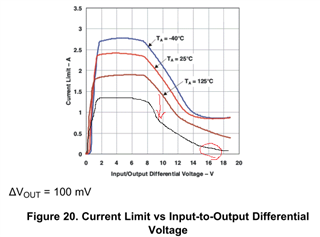Tool/software:
Hi team,
Please tell me the thermal shutdown temperature of TPS7A4501.
In an actual load short circuit test, the output is repeatedly turned on and off at approximately 175°C.
Best regards,
This thread has been locked.
If you have a related question, please click the "Ask a related question" button in the top right corner. The newly created question will be automatically linked to this question.
Tool/software:
Hi team,
Please tell me the thermal shutdown temperature of TPS7A4501.
In an actual load short circuit test, the output is repeatedly turned on and off at approximately 175°C.
Best regards,
Hi Kobayashi- San,
TPS7A45 does not have a thermal shutdown as is found in many LDO's. The primary thermal protection for this device is to reduce the current as the input-to-output voltage increases in order to keep the power transistor in the safe operating region. It is possible under specific conditions to cause a latch; however, under most conditions this is not a latching thermal protection. Please read section 8.3.3 of the datasheet for more information.
"In an actual load short circuit test, the output is repeatedly turned on and off at approximately 175°C" - Is this the test procedure or is this how the device actually behaved? The recommended operating junction temperature range maxes out at 125 °C and the absolute maximum is 150 °C.
Best regards
Ishaan
Hi Ishaan,
・The device is stable at 175°C in load short circuit testing, but will the output ever be turned off due to temperature?
・Does the SOA graph in the datasheet further reduce the current as the ambient temperature increases?
I know the operating temperature of the device, but since a load short circuit is a possibility I need to know how it will behave.

Best regards,
In order to limit the heat dissipation, the SOA protection allows a higher output current at small input to output differential voltages and a smaller output current at high input to output differential voltages. The idea of thermal shutdown is to decrease the output current even to zero, when a certain die temperature is reached and not even the least output current is allowed to flow anymore in order to prevent the die from damage. Instead in this device, the current limit is dynamically reduced as thermal dissipation increases until the operating current hits this limit and the device shuts off.
As ambient temperature rises, the device retains more heat (doesn't cool easily). So, the current limit is reduced more compared to lower temperatures.